Editorial: Another F for Alphabet: Google's Android Wear OS still 'half baked' after five ...
A decade ago, Google's Android platform targeted the stars: first swaggering into Apple's iPhone market, then aggressively following iPad into tablets, and more recently jumping into wearables well before Apple Watch was even announced. What has stopped Android from succeeding anywhere apart from replacing Symbian, Windows Mobile, or Java on lower-end phones?
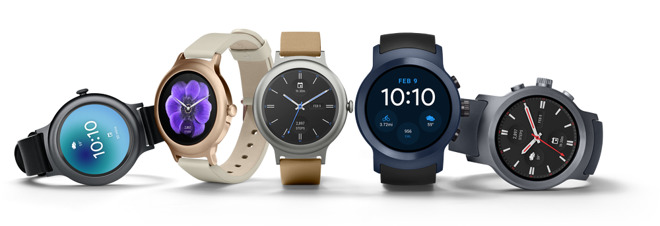
Nobody's wearing Wear OS
This week marks the fifth anniversary of Google's March 28, 2014 announcement of Android Wear, the specialized flavor of Android that Google hoped to use to enter and dominate the market for wearables. Yet rather than celebrating, Android Authority complained with the headline "Five years of Wear OS and it's still too messy to recommend."
"After five years of development and refinement," wrote C. Scott Brown, "you'd think Wear OS would be a strong contender within the wearable industry and something a reviews site like Android Authority would recommend. However, that's not really the case."
Brown's bleak pessimism of Wear OS this week is particularly notable because just a few months ago in August he quite optimistically wrote that Google was expected to "roll out a Wear OS redesign that will dramatically change the way you interact with your smartwatch," while envisioning that the search giant "might also launch its very first Google-branded smartwatch" alongside new Pixel phones.
That rumor failed to materialize. Just six months later, Brown has now decided that "Wear OS is still very messy and feels at times like a half-baked product."
"Half-baked" is the same phrase that The Verge used to describe Google's Pixel Slate, or that ExtremeTech used to describe the Pixel C, or that developers use to describe Bluetooth working on Pixel XL under Android 8.0, or that I used to describe Android Market back in 2010.
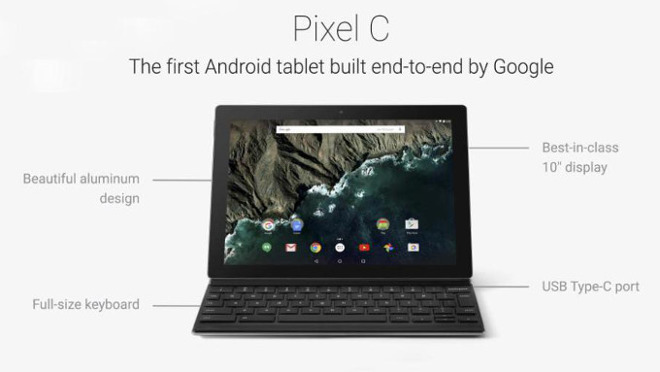
Like Wear OS, Android fan reviews also called Pixel C "half-baked"
There seems to be a lot of "half baking" going on at Google. This appears to be related to Google's haste in trying to beat Apple to market rather than working to actually take the time to create, develop, and refine products that anyone will actually want to buy.
It also freshly reset its version number to 1.0 from the existing Android Wear 2.9. "However," as Brown wrote, "it didn't feel like a new product worthy of a new name -- instead, it felt like Android Wear 3.0."
He added, "one thing you'll hear over and over when people talk about Wear OS is how it feels unrefined, half-baked, or otherwise incomplete. A lot of this has to do with how slow and buggy the operating system feels -- even on the latest-and-greatest hardware."
Google's "baking" problem is not correcting itself with the passage of time. Cherlynn Low, writing for Engadget, tried to put a nicer spin on the stagnancy of Wear OS on its fifth birthday, calling it "older, wiser, but unpolished."
Low's happy-facing of what is effectively a cadaver rambled on at length before finally concluding that "the industry is far less excited about wearables now than it was when Android Wear launched, and it's hard to imagine how Google's OS can get people to care about smartwatches."
But rather than squarely blaming Wear OS's half baked lack of polish on Google, Low mused that perhaps it was fate, writing "Wear OS' life story so far is emblematic of the trajectory of the category: We haven't come very far in five years, and I don't see us going much farther in the next five."
Perhaps Endadget has some sort of contractual inability to hold Google accountable for anything it does, but it sure sounds disingenuous to pretend with a straight face that "the category" hasn't "come very far in five years."
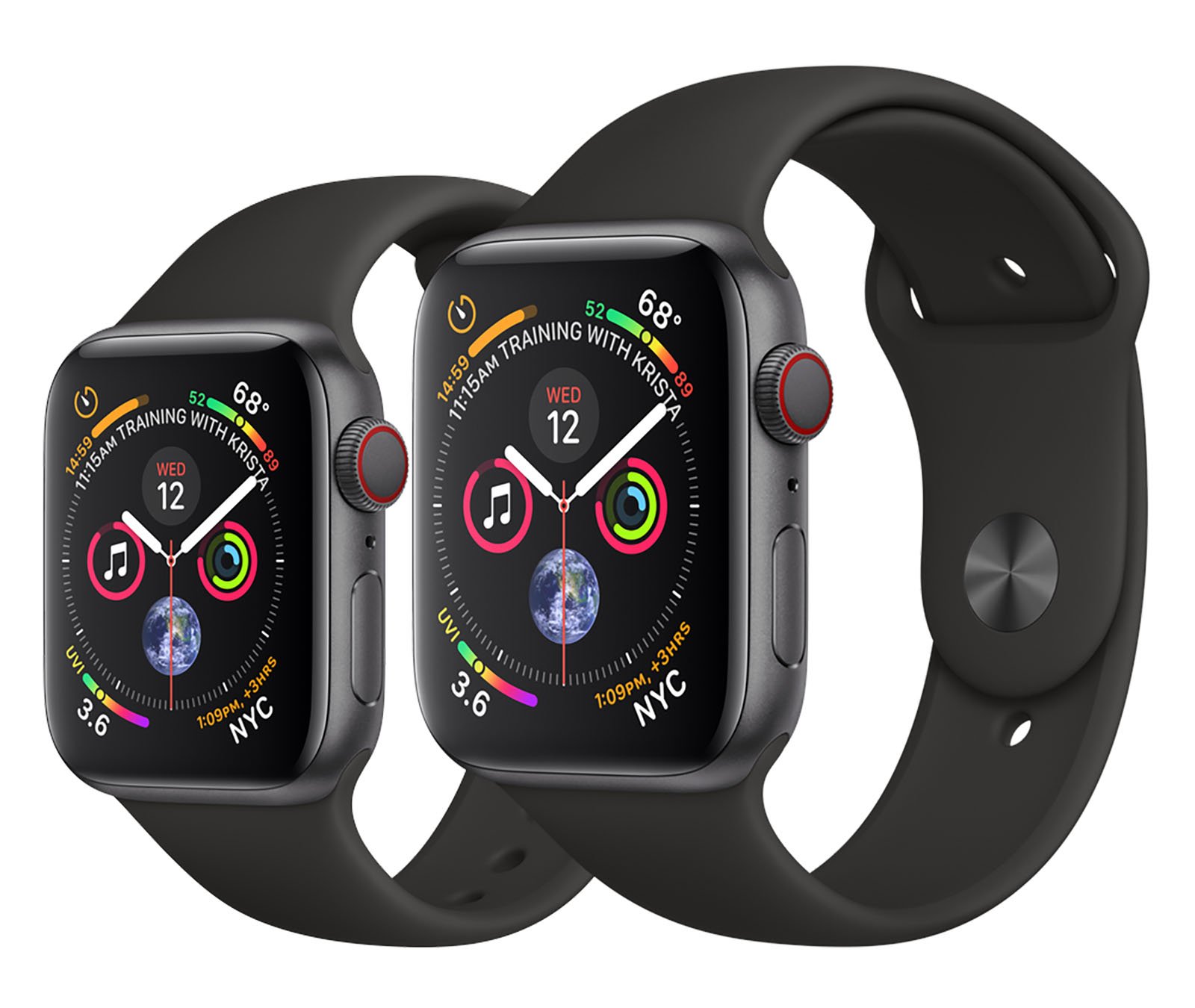
Apple Watch has come a long way in less than five years
Apple Watch has radically leaped from being more than a year behind the launch of Android smartwatches to being too far ahead to imagine anyone else might ever catch up. And sales volumes of rival watches are so low that there's simply nobody to pay for the advances in the silicon needed to power tomorrow's wearables.
The "the latest-and-greatest hardware" available to Watch OS vendors is laughably ancient compared to the aggressive advancement Apple's been making between its first Watch and today's Series 4, which sports an advanced S4 "Silicon in Package" chip. There aren't even any other devices that run entirely on a SiP, let alone the fourth generation of such package technology.
Google's having an impossibly difficult time getting anyone to pay a premium for an advanced smartphone, let alone a tablet, a notebook or a wearable-- certainly one of the most luxuriously optional categories of electronics.
And Apple isn't just forging ahead with Apple Watch. It's also taking a decisive lead in wearable wireless audio with AirPods, and appears to working on Augmented Reality glasses and other concepts that will be even harder for commodity Android phone producers to bring to market, let alone sell in meaningful, sustainable volumes.
Is there any reason to think that Google's Android may somehow jump ahead, or even catch up in some significant way? The history of Google's husbandry of Android paints a bleak picture of a frustrated cat herder who doesn't really even seem to like cats.
Google's initial 2008 unveiling of Android as a platform occurred well over a year after Apple began shipping iPhone as a finished product to the mass market; the first Android phones didn't have much real impact until all the other licensed platform options-- notably Symbian and Windows Mobile-- had failed. Once licensees had no other realistic option, Android began seeing widespread adoption among smartphone makers trying to catch up with Apple's iPhone.
In 2010, Google dumped its first phone partner HTC for a romance with the richer and more successful Motorola, which it eventually married. Despite efforts to fashion Google+Motorola as a power couple with the manufacturing resources, engineering genius, and industry clout to destroy Apple, the reality was that the partnership was toxic, blowing through billions of dollars in losses without much to show for it.
And just as Android began finding adoption on phones, Google decided to put Android's smartphone development on standby to focus its attention on making what it imagined to be an even better tablet than Apple's iPad.
That occurred with the development of Android 3.0 Honeycomb, a release specific to tablets like Motorola's 2011 Xoom. Still, Xoom was still struggling to ship as a functional tablet well over a year after iPad appeared.
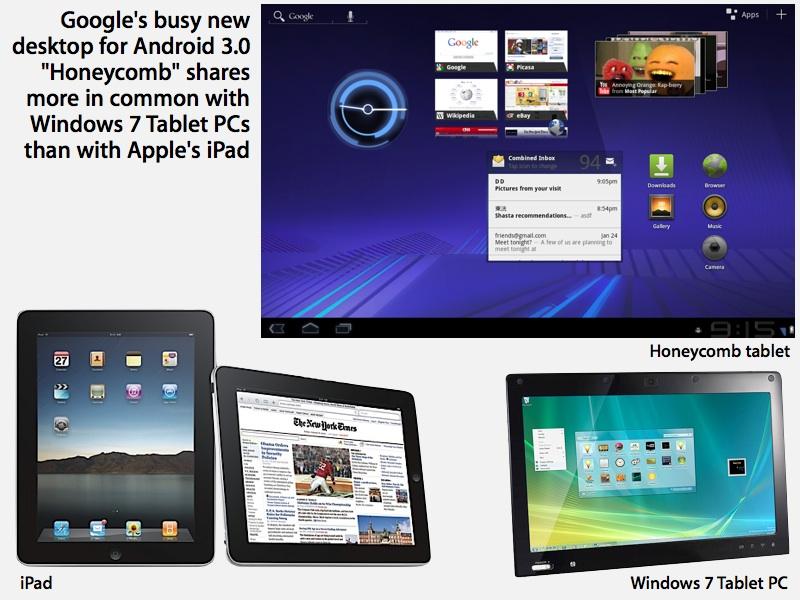
Google targeted Android 3.0 Honeycomb at iPad, although it attempted to create an original product
Polyamourous partnerships with virtually everyone else in the industry-- including leading PC and consumer electronics companies such as HP and Samsung-- were supposed to accelerate this trend, outmatching Apple in sheer volume and leveraging all the "innovation" that engineers working across all these various companies could collectively hive-mind.
However, the love-in that Android was fronting for the tech media was fake. Behind the scenes, Google's Android partners were not happy with being merely used as reproduction units while Google skimmed off all the easy advertising and app sale profits for itself. Further, Google was an abusive partner, maliciously killing their experiments while seeking to rein in every aspect of their business to ensure that it was the primary beneficiary of the relationship.
Just within 2010, Google pushed Samsung to not ship its new "Galaxy Tab" Android 2.x tablet prior to the release of Honeycomb. It similarly stymied HP's AirLife project, an Android-based mobile notebook, because it, too, didn't fit into Google's rigid idea of what Android should be used for. Effectively, while Google talked about being open, it was only really interested in copying Apple's proven successes.
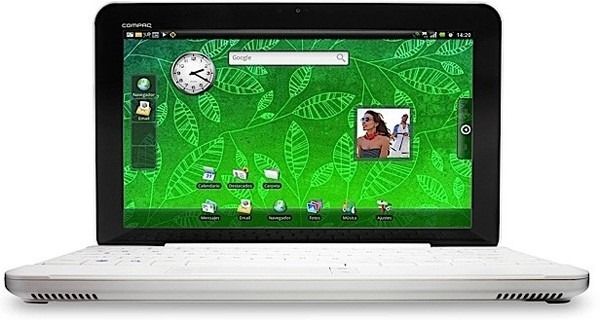
HP's Android-based AirLife was suffocated in part by Google's opposition's
Also in 2010, Google launched "Nexus" as its own house brand. It rather clearly laid out that the reason it needed to do this was because its hardware partners were incompetent buffoons screwing up its grand vision for Android with shoddy hardware designs and bloated software add-ons. Yet the original premise of Android was that these various awful partners tainting "Pure Android" were going to collectively vault Google ahead of Apple because they were so competent as experienced industry incumbents.
By the end of that year, that logic was switched around once again. Google's Motorola released the Moto 360, and Android fans spoke of it as if it were attractive and something they might consider after a few generations of fully baking. This time, it was growing clear that the real problem with Android in wearables wasn't the fault of Google's dimwitted partners but actually Google's software platform itself. It just wasn't finished or usable.
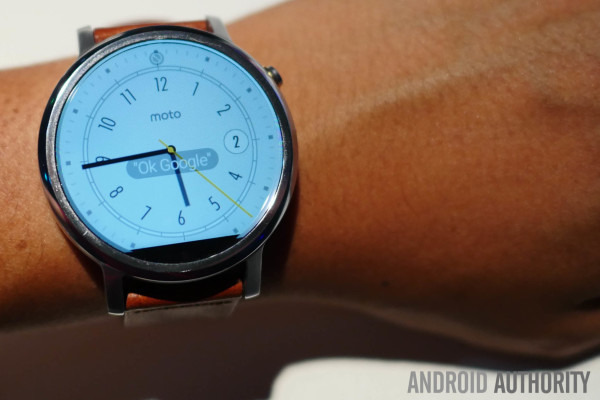
Moto 360 with bizarre flat tire display. Source: Android Authority
Google had been crowing that Androids were collectively outselling Apple's iPhone and iPad, although the company also clearly knew that none of its partners were making any money on tablet sales, none were close to Apple in smartphone profits and that its own Nexus efforts were a huge money pit.
As it began taking over Motorola, Google's executives described that company's internal product pipeline as something that needed to be "drained," as if it were an impacted sewer pipe of unbridled incompetence that only Google alone could solve. Yet as a subsidiary of Google, Motorola wasn't cranking out any hits.
In particular, Google had tasked Motorola with building the Moto 360 as a definitive Android Wear watch, hoping it would help Android to own the smartwatch category before Apple could even introduce the wearable it had been working on. Yet the watches Google and its partners debuted were not attractive at any price point.
Despite finally having a solid, year-long lead over Apple in a new product category, Google squandered any advantage, tainted its own brand, and nearly turned the category into a joke before Apple appeared with an entirely different take on how to deliver a wrist-worn computer.
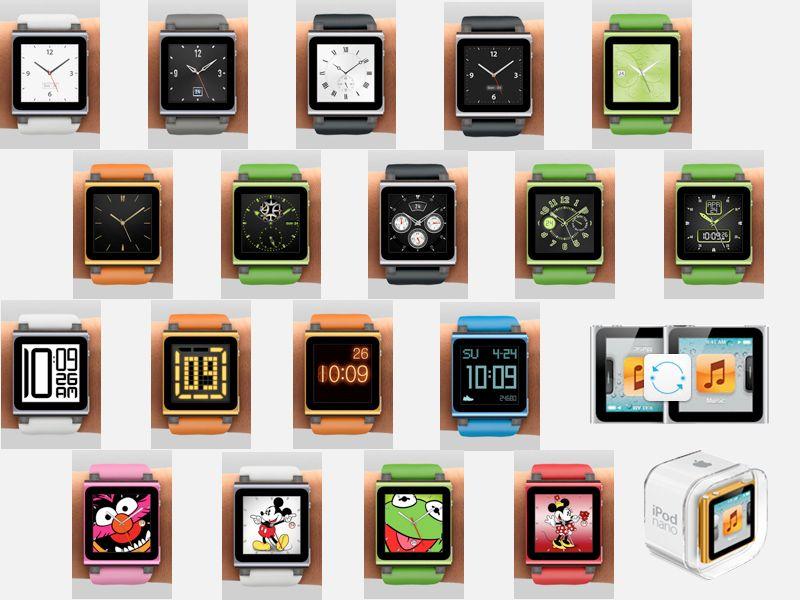
In 2011, Apple was overtly selling iPod nano as a watch
iPods had pioneered the art of wearable micro-electronics in mass production. Between 2012 and 2014, Apple pulled its wrist-wearable "Fat" iPad nano off the market and initiated a dramatic rethinking of what a wearable could be. More than just a clunky iPod strapped to the wrist, Tim Cook's Apple envisioned a fashionable luxury product with advanced heart and activity tracking for athletes, offered in a broad range of finishes, materials, and stylish bands that could suit anyone's personal sense of style.
Apple built out a new team to determine how a future iPod wearable could be made dramatically more powerful by leveraging the technologies in iOS, including things like Notifications, Siri, wireless Continuity for seamlessly moving tasks from one device to another, and Wallet passes.
Apple Watch also involved the development of entirely new features including heartbeat monitoring, Apple Pay, weatherproofing, wireless charging, and OLED screen technology, and sought to create a new system of swipe gestures and screen pressure sensitivity that would make sense on device with a small display.
These Apple Watch features not only made money on their own within Apple's profitable Other Hardware segment, but also contributed toward the future of iPhone. Features like 3D Touch, tap to wake, IP67 water resistance, wireless charging and Quick Start-- based on the "luxurious" setup process where users simply view an animated particle field QR-like 3D barcode on the watch display from their iPhone in order to establish a secure wireless link-- were all technologies first developed for Apple Watch.
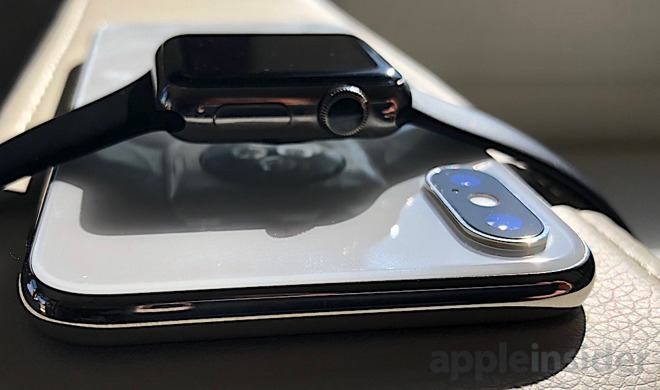
Apple Watch laid a foundation for iPhone X
The new Digital Crown was intended to make Apple Watch feel like an upscale fashion timepiece rather than a wrist-worn computer. And a variety of high-end materials, from stainless steel and sapphire to solid gold, were used to elevate the perceived value of the device and justify pricing that could support sustainable profits. Fashionable bands in shifting seasonal colors, along with designs from a variety of partners ranging from Nike to Hermes, contribute to ongoing revenues and an air of sophistication that set Apple Watch apart.
IDC in particular incinerated its credibility by claiming that early Apple Watch sales were only about tied with a Chinese factory cranking out a "band" that sold for around $25, often discounted to around $13.
That let the firm portray-- at least in its public-facing PR fake news announcements-- that the $1.44 billion market debut of Apple Watch was only "within striking distance of the market leader" Fitbit, which had only earned around $390 million in the same quarter. IDC even insisted that Apple was roughly tied with China's Xiaomi, which had only generated sport band revenues of at best $77 million, by focusing on unit shipments rather than actual economic activity.
At an average selling price of around $300, Apple Watch has been generating billions each year since its launch, yet IDC has portrayed up-as-down in telling anyone who would listen to its manufactured statistics about how little "share" of the market Apple was attracting, at least in terms of unit shipments of anything that could be described as "worn."
IDC's sham Potemkin Village of "wearable" sales was copied directly from earlier efforts to marginalize the success of iPad by comparing it to "children's toys," portable TVs, and really any other device that shipped with an ARM processor and wasn't a phone.
If IDC had dreamed up its phony framing of Apple's latest multi-billion dollar businesses as being merely "a failure to out-ship the rest of the world's collective production of anything remotely similar" a decade earlier, it might have also convinced the world that Steve Jobs' massively successful iPod phenomenon of the early 2000s was nothing more than an inconsequential minority market slice when compared to China's vast production of MP3 players, USB sticks, and plastic toys in the shape of a radio.
Conversely, if IDC and other market research groups hadn't created the illusion of failure for Apple Watch, it may have either forced Google, its partners, and other smartwatch makers to give up earlier, or it might have put more of an onus on them to deliver better products in a doubled down effort to actually compete with Apple, rather than just basking in praise while delivering unattractive, "half baked" products that nobody ultimately wanted to pay anything for.
Google and Samsung had been butting heads since 2010's Galaxy Tab, but now the world's largest Android licensee was ready to follow its own muse, without the supposed benefits of being locked into a "free and open" platform strictly controlled by Google and shared among all of Apple's competitors.
Samsung has also used Tizen in its smart TVs and other home-based products where Google doesn't offer it any platform advantage. In fact, this year Samsung is partnering with Apple to adopt AirPlay 2 in its televisions, a clear indication that within the TV set business that Samsung leads, compatibility with Apple's protocols is increasingly far more important than running Android apps.
On Android phones and even tablets, at least Google can put ads everywhere and glean some revenue from app sales. Ads and apps aren't going to support a sophisticated watch platform, where ad banners are far less tolerable and app sales aren't significant. And because Google cluelessly aimed its watch platform at nerdy, techy users, there's no hope of Wear OS ever realistically supporting a selection of either sporty or luxuriously fashionable bands.
A more serious problem for Google in wearables is that after spectacularly failing to create any real Android watch business-- even an imitative, low-end category it can use to shovel advertisements toward like Android phones-- Google lacks the foundation for building the next stage of wearables.
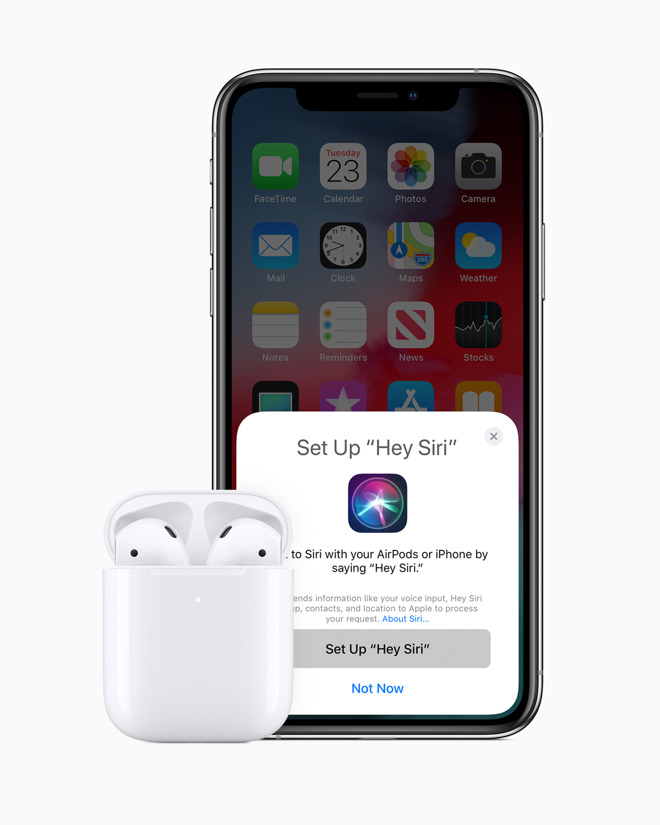
Google was first with an always-listening Assistant, but Apple now has Hey Siri working on iPads, Apple Watch and new AirPods, while Google has failed to sell tablets, watches or other new wearables
In contrast, Apple is not only gearing up to deliver watchOS 6 and doubling down on a very successful play into sports, fashion, health care, and home automation with its Apple Watch models but has also created a new kind of ecosystem stickiness: Apple Watch only works with iPhones. That means every user Apple can swoon into wearing its Watch will also not even be considering Android when they upgrade their phone.
And while short-sighted columnists were once touting analog headphone jacks as the reason to stick with Androids, while condemning Apple's move as "user hostile and stupid," Apple laid out a model where AirPods can work seamlessly between your iPhone, iPad, Mac, and Apple Watch-- without any jacks or wires. Users who wear an Apple Watch are likely to also adopt AirPods or Powerbeats to benefit from Apple's slick wireless integration delivered by custom silicon.
Rather than playing up its attempt to temporarily "save" headphone jacks to the delight of its fans in the tech media, Google could have been innovating toward a more wearable-friendly, wireless future, solving real problems rather than salving imaginary ones.
After blowing it in wearables, Google can't ask for the last five years back. Wear OS stands as more evidence that Android has very little real value outside of delivering high volumes of lower-end phone hardware that isn't very profitable.

Nobody's wearing Wear OS
Google's "half-baked" wearables effort
This week marks the fifth anniversary of Google's March 28, 2014 announcement of Android Wear, the specialized flavor of Android that Google hoped to use to enter and dominate the market for wearables. Yet rather than celebrating, Android Authority complained with the headline "Five years of Wear OS and it's still too messy to recommend."
"After five years of development and refinement," wrote C. Scott Brown, "you'd think Wear OS would be a strong contender within the wearable industry and something a reviews site like Android Authority would recommend. However, that's not really the case."
Brown's bleak pessimism of Wear OS this week is particularly notable because just a few months ago in August he quite optimistically wrote that Google was expected to "roll out a Wear OS redesign that will dramatically change the way you interact with your smartwatch," while envisioning that the search giant "might also launch its very first Google-branded smartwatch" alongside new Pixel phones.
That rumor failed to materialize. Just six months later, Brown has now decided that "Wear OS is still very messy and feels at times like a half-baked product."
"Half-baked" is the same phrase that The Verge used to describe Google's Pixel Slate, or that ExtremeTech used to describe the Pixel C, or that developers use to describe Bluetooth working on Pixel XL under Android 8.0, or that I used to describe Android Market back in 2010.
Like Wear OS, Android fan reviews also called Pixel C "half-baked"
There seems to be a lot of "half baking" going on at Google. This appears to be related to Google's haste in trying to beat Apple to market rather than working to actually take the time to create, develop, and refine products that anyone will actually want to buy.
Why isn't Wear OS fully baking?
A year ago, Google rebranded Android Wear under the new name "Wear OS by Google," noting that a third of its Android Wear watch owners were iPhone users.It also freshly reset its version number to 1.0 from the existing Android Wear 2.9. "However," as Brown wrote, "it didn't feel like a new product worthy of a new name -- instead, it felt like Android Wear 3.0."
He added, "one thing you'll hear over and over when people talk about Wear OS is how it feels unrefined, half-baked, or otherwise incomplete. A lot of this has to do with how slow and buggy the operating system feels -- even on the latest-and-greatest hardware."
Google's "baking" problem is not correcting itself with the passage of time. Cherlynn Low, writing for Engadget, tried to put a nicer spin on the stagnancy of Wear OS on its fifth birthday, calling it "older, wiser, but unpolished."
Low's happy-facing of what is effectively a cadaver rambled on at length before finally concluding that "the industry is far less excited about wearables now than it was when Android Wear launched, and it's hard to imagine how Google's OS can get people to care about smartwatches."
But rather than squarely blaming Wear OS's half baked lack of polish on Google, Low mused that perhaps it was fate, writing "Wear OS' life story so far is emblematic of the trajectory of the category: We haven't come very far in five years, and I don't see us going much farther in the next five."
Perhaps Endadget has some sort of contractual inability to hold Google accountable for anything it does, but it sure sounds disingenuous to pretend with a straight face that "the category" hasn't "come very far in five years."

Apple Watch has come a long way in less than five years
Apple Watch has radically leaped from being more than a year behind the launch of Android smartwatches to being too far ahead to imagine anyone else might ever catch up. And sales volumes of rival watches are so low that there's simply nobody to pay for the advances in the silicon needed to power tomorrow's wearables.
The "the latest-and-greatest hardware" available to Watch OS vendors is laughably ancient compared to the aggressive advancement Apple's been making between its first Watch and today's Series 4, which sports an advanced S4 "Silicon in Package" chip. There aren't even any other devices that run entirely on a SiP, let alone the fourth generation of such package technology.
Google's having an impossibly difficult time getting anyone to pay a premium for an advanced smartphone, let alone a tablet, a notebook or a wearable-- certainly one of the most luxuriously optional categories of electronics.
And Apple isn't just forging ahead with Apple Watch. It's also taking a decisive lead in wearable wireless audio with AirPods, and appears to working on Augmented Reality glasses and other concepts that will be even harder for commodity Android phone producers to bring to market, let alone sell in meaningful, sustainable volumes.
Is there any reason to think that Google's Android may somehow jump ahead, or even catch up in some significant way? The history of Google's husbandry of Android paints a bleak picture of a frustrated cat herder who doesn't really even seem to like cats.
Google's Android shadows iOS for five years: 2008-2013
Prior to the early 2014 announcement of Android Wear, Google had mostly only followed Apple's development direction with iOS-- in large part because Apple had demonstrated such incredible success in launching iPhone and then iPad, and in selling both to reach mass markets globally.Google's initial 2008 unveiling of Android as a platform occurred well over a year after Apple began shipping iPhone as a finished product to the mass market; the first Android phones didn't have much real impact until all the other licensed platform options-- notably Symbian and Windows Mobile-- had failed. Once licensees had no other realistic option, Android began seeing widespread adoption among smartphone makers trying to catch up with Apple's iPhone.
In 2010, Google dumped its first phone partner HTC for a romance with the richer and more successful Motorola, which it eventually married. Despite efforts to fashion Google+Motorola as a power couple with the manufacturing resources, engineering genius, and industry clout to destroy Apple, the reality was that the partnership was toxic, blowing through billions of dollars in losses without much to show for it.
And just as Android began finding adoption on phones, Google decided to put Android's smartphone development on standby to focus its attention on making what it imagined to be an even better tablet than Apple's iPad.
That occurred with the development of Android 3.0 Honeycomb, a release specific to tablets like Motorola's 2011 Xoom. Still, Xoom was still struggling to ship as a functional tablet well over a year after iPad appeared.

Google targeted Android 3.0 Honeycomb at iPad, although it attempted to create an original product
Google and the Android innovation problem
Google's "critics" were ecstatic about the future of Android, hopeful that it would not only result in me-too copies of Apple's products but also pave the way for new things Apple wasn't even trying. That included form factors like netbooks, TV computers, DVRs, set-top boxes, game consoles, and smart TV sets.Polyamourous partnerships with virtually everyone else in the industry-- including leading PC and consumer electronics companies such as HP and Samsung-- were supposed to accelerate this trend, outmatching Apple in sheer volume and leveraging all the "innovation" that engineers working across all these various companies could collectively hive-mind.
However, the love-in that Android was fronting for the tech media was fake. Behind the scenes, Google's Android partners were not happy with being merely used as reproduction units while Google skimmed off all the easy advertising and app sale profits for itself. Further, Google was an abusive partner, maliciously killing their experiments while seeking to rein in every aspect of their business to ensure that it was the primary beneficiary of the relationship.
Just within 2010, Google pushed Samsung to not ship its new "Galaxy Tab" Android 2.x tablet prior to the release of Honeycomb. It similarly stymied HP's AirLife project, an Android-based mobile notebook, because it, too, didn't fit into Google's rigid idea of what Android should be used for. Effectively, while Google talked about being open, it was only really interested in copying Apple's proven successes.

HP's Android-based AirLife was suffocated in part by Google's opposition's
Also in 2010, Google launched "Nexus" as its own house brand. It rather clearly laid out that the reason it needed to do this was because its hardware partners were incompetent buffoons screwing up its grand vision for Android with shoddy hardware designs and bloated software add-ons. Yet the original premise of Android was that these various awful partners tainting "Pure Android" were going to collectively vault Google ahead of Apple because they were so competent as experienced industry incumbents.
Google beat Apple Watch to market, but it didn't matter
By 2013, Google felt ready to ambitiously expand beyond simply copying Apple's iPhone and iPad. It prepared the launch of Android Wear, which it expected to enable an entirely new class of wearable devices, starting with wrist-worn smartwatches. Yet rather than launching its own Nexus Watch, Google again returned to speaking of its licensees as brilliant innovators and again delegated the instantiation of the wearable experience to Samsung and LG.By the end of that year, that logic was switched around once again. Google's Motorola released the Moto 360, and Android fans spoke of it as if it were attractive and something they might consider after a few generations of fully baking. This time, it was growing clear that the real problem with Android in wearables wasn't the fault of Google's dimwitted partners but actually Google's software platform itself. It just wasn't finished or usable.

Moto 360 with bizarre flat tire display. Source: Android Authority
Google had been crowing that Androids were collectively outselling Apple's iPhone and iPad, although the company also clearly knew that none of its partners were making any money on tablet sales, none were close to Apple in smartphone profits and that its own Nexus efforts were a huge money pit.
As it began taking over Motorola, Google's executives described that company's internal product pipeline as something that needed to be "drained," as if it were an impacted sewer pipe of unbridled incompetence that only Google alone could solve. Yet as a subsidiary of Google, Motorola wasn't cranking out any hits.
In particular, Google had tasked Motorola with building the Moto 360 as a definitive Android Wear watch, hoping it would help Android to own the smartwatch category before Apple could even introduce the wearable it had been working on. Yet the watches Google and its partners debuted were not attractive at any price point.
Despite finally having a solid, year-long lead over Apple in a new product category, Google squandered any advantage, tainted its own brand, and nearly turned the category into a joke before Apple appeared with an entirely different take on how to deliver a wrist-worn computer.
Rather than scrambling to be first, Apple Watch aimed at being more valuable
Instead of scaling down a smartphone and figuring out how to install it in a can that could be strapped to a wrist as Google did, Apple started from a proven model of success: its 6G iPad nano, a device that users had already started wearing with third-party bands to take their music on the go.
In 2011, Apple was overtly selling iPod nano as a watch
iPods had pioneered the art of wearable micro-electronics in mass production. Between 2012 and 2014, Apple pulled its wrist-wearable "Fat" iPad nano off the market and initiated a dramatic rethinking of what a wearable could be. More than just a clunky iPod strapped to the wrist, Tim Cook's Apple envisioned a fashionable luxury product with advanced heart and activity tracking for athletes, offered in a broad range of finishes, materials, and stylish bands that could suit anyone's personal sense of style.
Apple built out a new team to determine how a future iPod wearable could be made dramatically more powerful by leveraging the technologies in iOS, including things like Notifications, Siri, wireless Continuity for seamlessly moving tasks from one device to another, and Wallet passes.
Apple Watch also involved the development of entirely new features including heartbeat monitoring, Apple Pay, weatherproofing, wireless charging, and OLED screen technology, and sought to create a new system of swipe gestures and screen pressure sensitivity that would make sense on device with a small display.
These Apple Watch features not only made money on their own within Apple's profitable Other Hardware segment, but also contributed toward the future of iPhone. Features like 3D Touch, tap to wake, IP67 water resistance, wireless charging and Quick Start-- based on the "luxurious" setup process where users simply view an animated particle field QR-like 3D barcode on the watch display from their iPhone in order to establish a secure wireless link-- were all technologies first developed for Apple Watch.

Apple Watch laid a foundation for iPhone X
The new Digital Crown was intended to make Apple Watch feel like an upscale fashion timepiece rather than a wrist-worn computer. And a variety of high-end materials, from stainless steel and sapphire to solid gold, were used to elevate the perceived value of the device and justify pricing that could support sustainable profits. Fashionable bands in shifting seasonal colors, along with designs from a variety of partners ranging from Nike to Hermes, contribute to ongoing revenues and an air of sophistication that set Apple Watch apart.
IDC's invention of failure framing
Pundits and analysts slobbered all over themselves to rush out their hot takes about how terribly far behind everyone else Apple Watch was, and research groups churned out endless data seeking to establish that Apple's share of the smartwatch market was tiny to start with and probably shrinking, especially when they threw in shipments of anything that could tenuously be described as "wearable."IDC in particular incinerated its credibility by claiming that early Apple Watch sales were only about tied with a Chinese factory cranking out a "band" that sold for around $25, often discounted to around $13.
That let the firm portray-- at least in its public-facing PR fake news announcements-- that the $1.44 billion market debut of Apple Watch was only "within striking distance of the market leader" Fitbit, which had only earned around $390 million in the same quarter. IDC even insisted that Apple was roughly tied with China's Xiaomi, which had only generated sport band revenues of at best $77 million, by focusing on unit shipments rather than actual economic activity.
At an average selling price of around $300, Apple Watch has been generating billions each year since its launch, yet IDC has portrayed up-as-down in telling anyone who would listen to its manufactured statistics about how little "share" of the market Apple was attracting, at least in terms of unit shipments of anything that could be described as "worn."
IDC's sham Potemkin Village of "wearable" sales was copied directly from earlier efforts to marginalize the success of iPad by comparing it to "children's toys," portable TVs, and really any other device that shipped with an ARM processor and wasn't a phone.
If IDC had dreamed up its phony framing of Apple's latest multi-billion dollar businesses as being merely "a failure to out-ship the rest of the world's collective production of anything remotely similar" a decade earlier, it might have also convinced the world that Steve Jobs' massively successful iPod phenomenon of the early 2000s was nothing more than an inconsequential minority market slice when compared to China's vast production of MP3 players, USB sticks, and plastic toys in the shape of a radio.
Conversely, if IDC and other market research groups hadn't created the illusion of failure for Apple Watch, it may have either forced Google, its partners, and other smartwatch makers to give up earlier, or it might have put more of an onus on them to deliver better products in a doubled down effort to actually compete with Apple, rather than just basking in praise while delivering unattractive, "half baked" products that nobody ultimately wanted to pay anything for.
Samsung stops wearing Android
By the official launch of Android Wear in 2014, Samsung was already ready to give up on working with Google in wearables. Samsung hadn't been successful in launching its internal Tizen platform on smartphones, but it saw Tizen as a good enough for its Gear Fit, a simplified wearable that PC Mag observed "drops the rest of the [Android-powered] Galaxy Gear's gimmicks, like phone calls and the built-in camera."Google and Samsung had been butting heads since 2010's Galaxy Tab, but now the world's largest Android licensee was ready to follow its own muse, without the supposed benefits of being locked into a "free and open" platform strictly controlled by Google and shared among all of Apple's competitors.
Samsung has also used Tizen in its smart TVs and other home-based products where Google doesn't offer it any platform advantage. In fact, this year Samsung is partnering with Apple to adopt AirPlay 2 in its televisions, a clear indication that within the TV set business that Samsung leads, compatibility with Apple's protocols is increasingly far more important than running Android apps.
The ad emperor's unwearable new clothes
With Wear OS, Google has poured tons of money into a wearable platform that is effectively worthless in its current half-baked state, and there isn't really any business model to support continued baking.On Android phones and even tablets, at least Google can put ads everywhere and glean some revenue from app sales. Ads and apps aren't going to support a sophisticated watch platform, where ad banners are far less tolerable and app sales aren't significant. And because Google cluelessly aimed its watch platform at nerdy, techy users, there's no hope of Wear OS ever realistically supporting a selection of either sporty or luxuriously fashionable bands.
A more serious problem for Google in wearables is that after spectacularly failing to create any real Android watch business-- even an imitative, low-end category it can use to shovel advertisements toward like Android phones-- Google lacks the foundation for building the next stage of wearables.

Google was first with an always-listening Assistant, but Apple now has Hey Siri working on iPads, Apple Watch and new AirPods, while Google has failed to sell tablets, watches or other new wearables
In contrast, Apple is not only gearing up to deliver watchOS 6 and doubling down on a very successful play into sports, fashion, health care, and home automation with its Apple Watch models but has also created a new kind of ecosystem stickiness: Apple Watch only works with iPhones. That means every user Apple can swoon into wearing its Watch will also not even be considering Android when they upgrade their phone.
And while short-sighted columnists were once touting analog headphone jacks as the reason to stick with Androids, while condemning Apple's move as "user hostile and stupid," Apple laid out a model where AirPods can work seamlessly between your iPhone, iPad, Mac, and Apple Watch-- without any jacks or wires. Users who wear an Apple Watch are likely to also adopt AirPods or Powerbeats to benefit from Apple's slick wireless integration delivered by custom silicon.
Rather than playing up its attempt to temporarily "save" headphone jacks to the delight of its fans in the tech media, Google could have been innovating toward a more wearable-friendly, wireless future, solving real problems rather than salving imaginary ones.
After blowing it in wearables, Google can't ask for the last five years back. Wear OS stands as more evidence that Android has very little real value outside of delivering high volumes of lower-end phone hardware that isn't very profitable.





Comments
Luv my Apple Watch.
Wamt more storage to carry more music though.
Tim, are you listening?
Like the current smart-speakers and headgear/smart-glasses markets where there's early leaders there's time for others to catch up. Maybe someone will. Wearables are still an immature market with huge growth potential in not only watches but eye-wear, ear wear, clothing, headsets, rings, future implants, etc. So yeah DED is correct. Even I would give Android a D+ on smartwatches. If not for the fashion options which matters to quite a few people it would be lower than that. Apple is currently in the lead in this one, and all said in two paragraphs.
Nice reference to the Potemkin Village. I wonder if the next five years will see Android itself come under fire. Bloated, buggy, and marginally stable, it's ripe to be taken down. Some upstart developer will come along with a nice clean mobile OS, that drops all the spyware/crapware/adware, and annoying weirdness of Android. An OS that just works for a phone/camera/music player/game player. If someone comes up with that, and will sell it to companies for, say $5 per phone no strings attached, they will be a billionaire and Google w2ill find its revenue from Android collapsing. I get the distinct feeling that a lot of companies making phones are sick of dealing with Google's underhanded incompetence.
I'm still using my series 0 with my 5S & love it. Might get a used 4 next year after I upgrade the phone.
Day 1: "Ooooh new toy!"
Day 2: "If this isn't compelling in the next 13 days, I may return it and save my money for something more deserving."
Day 3: "Wow, look at what this can do!"
Day 4: see Day 3
Day 5: "It's a keeper"
My two cents is everything here is predictable simply because as usual Google reacted as fast as they could to an Apple concept which may result in massive sales numbers but rarely profit. Not that their original concepts fair too well! I seem to recall many of us genuine Apple users on this blog (as opposed to a full-time tech journalist paid to post pro Google information 24/7) asked at the time '.. and how long till Google copies this?'
Here it all is summed up in a few news reports:
You say that WearOS is targeted to only tech users and never ever realistically supporting a selection of either sporty or luxuriously fashionable bands. What about the Diesel, MontBlanc, Skagen and Fossil watches then? Or do you really mean bands and not brands? In that case your point is even weaker, as most WearOS watches have support for standard watch bands, making the selection much larger compared to the ones of the Apple Watch.
The features you mention on the Apple Watch like wireless charging,weatherproofing and OLED were also available on WearOS watches, so why are these mentioned as features only the Apple Watch has?
And to be clear, I do not like WearOS.
i’ve said this in a lot of places over the years, but it still bears repeating. When an Watch costs, on average about a third, to less than a half of what the average iPhone costs, it’s going to get sales, because enough people see a value in an object like that at that price.
but so far, smart watches are going to cost a minimum of $300 for a full featured current model. When the worldwide Android phone price is $230, that’s untenable. If people won’t spend more on phones, why should they spend more for a smartwatch? The answer is that they won’t.
the excuse of poor hardware is hardly a real one either. When Android watches came out, about the same time the Watch came out, the hardware was about the same. Apple’s was a bit better, but not by much. Remember all the talk about how slow that first model was? But Apple got on the ball and reworked the OS, and fixed a lot of the problems before the second model came out.
if Android watches sold in credible quantities from the beginning, then Qualcomm, and likely others, would have advanced their hardware for it. But sales never took off, so Qualcomm wasn’t going to spend that much on a totally new chip for the purpose, and other than Samsung making chips for their own watches, nobody else has stood up.
so the situation gets worse. Fitbit is having some small success with their watches, and Garman is too. But Android Wear has been going nowhere, despite a few high end brands using it for limited functionality, and Fossil working with it.
unless the smartphone/smartwatch pricing problem can go away, this isn’t going to succeed.
The article is about the state of a competitor for one of Apple's major products.
And this bothers you why?